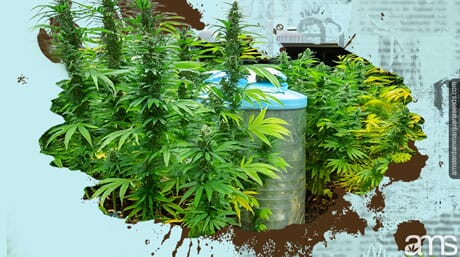As the world grapples with climate change and resource scarcity, a growing awareness has emerged around sustainable practices, especially in the area of cultivation. Green thumb enthusiasts, amateur horticulturists, and professional growers are all actively seeking environmentally-friendly methods to nourish their plants. Our focus for today’s discourse, however, pertains to a particular plant that’s stirred much debate and interest – cannabis.
In the burgeoning field of cannabis cultivation, we emphasize a resource that’s abundantly available, yet often overlooked – rainwater. This valuable, natural element holds immense potential in our cultivation practices, primarily due to its compatibility with the unique needs of cannabis plants. This comprehensive guide explores the multifaceted benefits of rainwater for cannabis irrigation, offering a deep dive into its inherent properties and significance.
Furthermore, it serves as a hands-on manual, outlining actionable tips and tricks to aid you in establishing an effective rainwater harvesting system. The aim here is not merely to inform but to equip you with the tools and knowledge needed for a self-sustained, eco-friendly cannabis cultivation journey right at home. It’s a testament to the harmony we can achieve between nature’s gifts and our cultivation practices.

Why Rainwater is the Best for Cannabis Cultivation
The assertion that rainwater is the optimum choice for cannabis cultivation derives its strength from various factors, central of which is rainwater’s inherent softness. This feature refers to its significantly lower mineral content compared to the relatively ‘hard’ tap water. It might seem counterintuitive – after all, aren’t minerals good for plants? However, when it comes to cannabis cultivation, this softness is indeed beneficial.
Cannabis plants, like many other flora, possess a symbiotic relationship with a category of fungi known as mycorrhizae. These mycorrhizae colonize the plant roots, facilitating improved nutrient and water uptake while protecting the roots from harmful pathogens. The softness of rainwater allows it to be easily absorbed by these fungal networks, thereby optimizing nutrient delivery to cannabis plants. This absorption efficiency promotes superior growth, enhancing the overall health and yield of the cannabis crop.
Rainwater also has a neutral pH level, a key factor in successful cannabis cultivation. Cannabis plants thrive in a slightly acidic to neutral pH range, around 6.0 to 7.0. Rainwater typically falls within this range, providing an optimal environment for nutrient absorption. It helps in the availability of vital nutrients like nitrogen, phosphorus, and potassium, thus encouraging healthier, more robust growth.
Using rainwater also brings us one step closer to sustainable cannabis cultivation. It allows growers to lower their dependence on municipal water supplies, many of which are treated with chemicals such as chlorine and chloramines that may be detrimental to the beneficial microbial life within the soil. This sustainability angle not only benefits the environment by conserving water but also leads to a cultivation method that aligns with nature’s rhythm, providing a naturally superior quality crop.
Setting Up Your Rainwater Collection System
As we embark on the journey of rainwater collection, the DIY approach opens up an exciting opportunity to create a system that aligns with your specific requirements and constraints. This process involves a few crucial steps, from selecting an ideal collection system to installing it correctly and ensuring its maintenance.

Choosing a Collection System: Picking the right container to collect rainwater is the first crucial step. Commercial rain barrels are readily available in various sizes and designs, fitting different budget ranges and aesthetic preferences. They typically come with built-in spigots, lids, and overflow mechanisms, making them a convenient choice for beginners. On the other hand, repurposing food-grade containers can be a cost-effective and eco-friendly alternative. Make sure your chosen container is sturdy, opaque (to prevent algae growth), and non-toxic. Remember to fit it with a secure lid to prevent debris and insect contamination and an overflow valve to deal with excess water.
Installation: Proper placement of your rain barrel is critical for effective collection. Locate it under a downspout that drains a large portion of your roof to maximize the capture of rainwater. Consider adding a diverter to the downspout, which directs water to the barrel when it’s raining and routes it away when it’s full. The base of your barrel should be stable and elevated – not only does this make accessing the spigot easier but it also increases water pressure, facilitating better flow when you’re irrigating your cannabis plants.
Water Treatment: While rainwater is typically clean, it can pick up pollutants as it travels down your roof, particularly if you live in an urban area with higher air pollution levels. To address this, consider adding a pre-filtration system. A simple method is using a screen mesh to filter out larger debris like leaves and twigs. For finer filtration, a roof washer system can be implemented. This system discards the first flush of rainwater, which carries the majority of contaminants, and only collects the cleaner water that follows. In any case, it’s important to routinely clean your barrel to maintain water quality.
By meticulously setting up your rainwater collection system, you are laying a solid foundation for a flourishing cannabis garden. This is a significant stride towards an environmentally-friendly cultivation approach that contributes to water conservation efforts while also meeting your cannabis plants’ unique needs.
Rainwater and Your Cannabis Plants
Now that you’ve successfully collected rainwater, the next step is to use this natural resource to nourish your cannabis plants. The process is not just about watering; it’s about understanding the unique water requirements of your plants at different growth stages, implementing proper irrigation techniques, and avoiding common mistakes like overwatering. This section provides an in-depth look at these aspects.

Understanding the Watering Needs of Your Cannabis Plants
The water requirement of cannabis plants varies throughout their life cycle. During the vegetative stage, cannabis plants are growing rapidly, putting out new leaves and branches, hence they need ample water. Regular watering at this stage ensures the plants get adequate moisture to support their vigorous growth.
However, as the plants enter the flowering stage, their water requirements change. They grow slower, and their focus shifts from leaf production to developing buds. Thus, they require less water compared to the vegetative stage. Overwatering during this phase can lead to problems like root rot and fungal diseases, potentially harming your yield.
Understanding these changing needs is essential for successful cannabis cultivation. It’s about achieving a balance – providing enough water for your plants to thrive, but not so much that it leads to detrimental conditions.
Implementing Proper Watering Techniques
When it comes to watering your cannabis plants, the methodology is as important as the frequency. A watering can or a hose attached to the spigot of your rain barrel can be used. However, it’s essential to water your plants slowly and evenly, allowing the water to seep into the soil gradually. This method ensures the water reaches the root zone effectively, promoting healthy root growth and nutrient uptake.
In container gardening, a common technique is to water until a little water comes out of the bottom of the container. This runoff indicates that the water has thoroughly penetrated the soil, ensuring that the roots throughout the pot have access to water. However, it’s important not to let the plants sit in this runoff, as it could lead to oversaturation.
In terms of frequency, cannabis plants typically prefer a cycle of wet and dry periods rather than constant moisture. A common approach is to water the plants thoroughly, then wait until the top inch or so of soil dries out before watering again. This method prevents overwatering while ensuring the plants receive enough hydration to grow healthily.

Monitoring Plant Health for Optimal Watering
Observing your plants is a key aspect of effective watering. Signs of overwatering include drooping leaves, yellowing, and a general appearance of being ‘overly lush.’ On the other hand, underwatered plants may also exhibit drooping, but they typically perk up quickly after being watered.
In conclusion, using rainwater for your cannabis plants involves more than merely replacing tap water. It requires an understanding of the plants’ unique water needs at different stages of growth, implementing proper watering techniques, and regularly observing the plants for any signs of distress. With careful attention and practice, using rainwater for cannabis cultivation can significantly enhance your plants’ health and yield, while also contributing to a sustainable and environmentally-friendly gardening practice.
In Conclusion: A Satisfying Cultivation Experience
Embracing rainwater as an irrigation resource for your cannabis cultivation brings about a profound sense of satisfaction. You’re not just nurturing plants; you’re stepping into the realm of sustainable, environmentally conscious gardening practices. The journey from setting up your own rainwater collection system to comprehending the specific needs of your cannabis plants, culminates in the joy of witnessing the fruits of your labor.
This immersive experience not only enriches your understanding of cannabis cultivation, but also fosters a deep sense of pride. You are equipped with practical, hands-on expertise, an asset of immense value in our increasingly eco-aware society. With the availability of rainwater, your homegrown marijuana plants can truly thrive, making your cultivation endeavors rewarding and fulfilling.
As we wrap up our discussion on harnessing rainwater for cannabis cultivation, it’s crucial to remind ourselves of the importance of legality. Always ensure that your cultivation practices comply with local laws and regulations concerning cannabis cultivation. The essence of sustainable cultivation lies in marrying harmony with nature and respect for the law.
In line with our commitment to providing a satisfying and enlightening experience, we recommend checking out Amsterdam Marijuana Seeds. This platform offers a variety of high-quality seeds and an array of cultivation guides. Whether you’re a novice or an experienced cultivator, you’ll find resources tailored to your needs, and seeds that’ll help you begin or continue your sustainable cannabis cultivation journey.
Embrace the green thumb within you, and embark on a responsible and satisfying cannabis cultivation journey.
Disclaimer: This content is meant for educational purposes only. It has been compiled with research from external sources. it is not meant to substitute any medical or legal advice. Please see your local laws for the legality of cannabis use.
- SEO Powered Content & PR Distribution. Get Amplified Today.
- PlatoData.Network Vertical Generative Ai. Empower Yourself. Access Here.
- PlatoAiStream. Web3 Intelligence. Knowledge Amplified. Access Here.
- PlatoESG. Automotive / EVs, Carbon, CleanTech, Energy, Environment, Solar, Waste Management. Access Here.
- BlockOffsets. Modernizing Environmental Offset Ownership. Access Here.
- Source: https://amsterdammarijuanaseeds.com/blog/sustainable-cannabis-cultivation-with-rainwater



